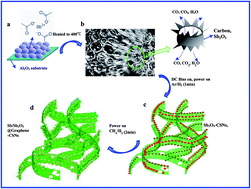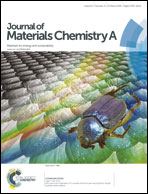Uniformly dispersed self-assembled growth of Sb2O3/Sb@graphene nanocomposites on a 3D carbon sheet network for high Na-storage capacity and excellent stability†
Abstract
Large volume changes cause a series of complicated problems in alloy-type anodes, such as pulverization, exfoliation and the capacity decay which results. Therefore, solutions for the problems caused by large volume changes in sodium ion battery (SIB) anodes are urgently needed. Herein, we report a novel route to encapsulate Sb2O3/Sb nanoparticles (Sb2O3/Sb-NPs) within a graphene shell nanostructure (Sb2O3/Sb@graphene) via microwave plasma irradiation of Sb(CH3COO)3 and a subsequent graphene growth procedure. The designed structure, Sb2O3/Sb@graphene NPs anchored on carbon sheet networks (CSNs), provides an ultra-thin, flexible graphene shell to accommodate the volume changes of Sb2O3/Sb, and thus demonstrates excellent cycling stability (92.7% of the desodiation capacity was retained after 275 cycles), a long cycle life (more than 330 cycles) and a good rate capability (220.8 mA h g−1 even at 5 A g−1). The stability could be compared to that of commercial graphite in lithium ion batteries.


 Please wait while we load your content...
Please wait while we load your content...